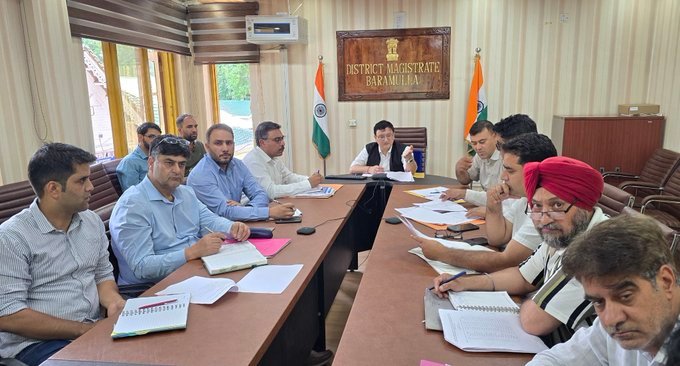Baramulla, June 14, 2025 – Deputy Commissioner (DC) of Baramulla, Minga Sherpa, chaired a pivotal meeting today to assess the progress of Eco-Sensitive Zone (ESZ) implementation in the district, emphasizing the urgent need for a robust Zonal Master Plan (ZMP) to safeguard its ecological heritage. Held at the DC Office, the meeting underscored the district’s commitment to balancing environmental conservation with sustainable development, particularly in ecologically fragile areas like Gulmarg and wildlife sanctuaries.
DC Sherpa directed all concerned departments to expedite the submission of accurate and comprehensive data to shape the Zonal Master Plan, a critical framework mandated by the Ministry of Environment, Forest and Climate Change (MoEFCC). The plan aims to regulate land use, tourism, and infrastructure development while prioritizing ecological protection and biodiversity conservation.
Strengthening Ecological Protection
The review focused on ensuring that ESZ guidelines are effectively implemented to protect Baramulla’s rich biodiversity. Eco-Sensitive Zones, designated around wildlife sanctuaries and other ecologically significant areas, serve as buffer zones to minimize environmental degradation from developmental activities. In Baramulla, these zones include areas near wildlife sanctuaries and popular tourist destinations like Gulmarg, which require careful management to preserve their natural splendor.
DC Sherpa stressed the importance of inter-departmental coordination to achieve the objectives of the ZMP. “Our goal is to create a sustainable roadmap that protects our environment while supporting responsible development. Accurate data from all departments is crucial to ensure the Zonal Master Plan reflects the realities on the ground,” he remarked.
Data Submission and Zonal Master Plan
Departments, including Agriculture, Horticulture, Industries, and Planning, were instructed to provide detailed data on land use patterns, existing infrastructure, environmental conditions, and ongoing projects. This data will form the foundation of the ZMP, which will outline permissible activities, such as eco-friendly tourism, while restricting ecologically harmful practices like mining and large-scale industrialization.
The ZMP, as per MoEFCC directives issued in October 2023, must be finalized within two years, involving consultations with local communities, environmental experts, and other stakeholders. The plan will also incorporate strategies to enhance eco-tourism, ensuring that destinations like Gulmarg remain sustainable while boosting the local economy.
Coordinated Action and Stakeholder Engagement
The meeting saw active participation from key stakeholders, including district officials, representatives from the Forest Department, and local planning authorities. DC Sherpa emphasized the need for a collaborative approach, urging departments to work in tandem with non-governmental organizations (NGOs) and community representatives. A dedicated monitoring committee, led by the Divisional Commissioner, Kashmir, will oversee the ZMP’s implementation, ensuring compliance with environmental standards.
The DC’s recent field visit to Gulmarg on June 12, 2025, further highlighted the administration’s proactive efforts to align tourism development with ecological goals. Initiatives like waste management and green infrastructure are being prioritized to maintain the ecological balance of the region.
Table: Overview of Eco-Sensitive Zone and Zonal Master Plan in Baramulla
| Component | Description |
|---|---|
| Objective | Promote ecological conservation while enabling sustainable development. |
| Primary Directive | Departments to submit realistic data for Zonal Master Plan preparation. |
| Key Focus Areas | Biodiversity protection, regulated land use, eco-friendly tourism. |
| Stakeholders Involved | DC Office, MoEFCC, Forest Department, NGOs, local communities, experts. |
| Timeline | ZMP to be finalized by October 2025, as per MoEFCC guidelines. |
| Monitoring Mechanism | Committee headed by Divisional Commissioner, Kashmir, with expert oversight. |
| Target Areas | Wildlife sanctuaries, Gulmarg, and other eco-sensitive regions in Baramulla. |
Baramulla’s Commitment to Sustainability
Baramulla, renowned for its scenic landscapes and biodiversity, faces the dual challenge of preserving its natural assets while fostering economic growth. The Zonal Master Plan is poised to serve as a blueprint for sustainable development, ensuring that future projects adhere to environmental norms. By restricting activities that threaten ecosystems, the plan aims to protect wildlife habitats and maintain the ecological integrity of the district.
DC Sherpa’s leadership in this initiative reflects the administration’s broader vision of positioning Baramulla as a model for environmental stewardship in Jammu and Kashmir. “Through coordinated action and community involvement, we can ensure that our natural heritage thrives alongside responsible development,” he stated.
Looking Ahead
Departments have been given a strict timeline to compile and submit their data, with the DC Office set to conduct follow-up reviews to monitor progress. The Zonal Master Plan will undergo public consultations to incorporate feedback from local residents, ensuring inclusivity and transparency. Once finalized, the plan is expected to set a precedent for eco-sensitive governance, reinforcing Baramulla’s commitment to ecological protection.
For updates on the Zonal Master Plan or to contribute to the consultation process, stakeholders are encouraged to contact the DC Office, Baramulla, or visit the official MoEFCC website for further information.




